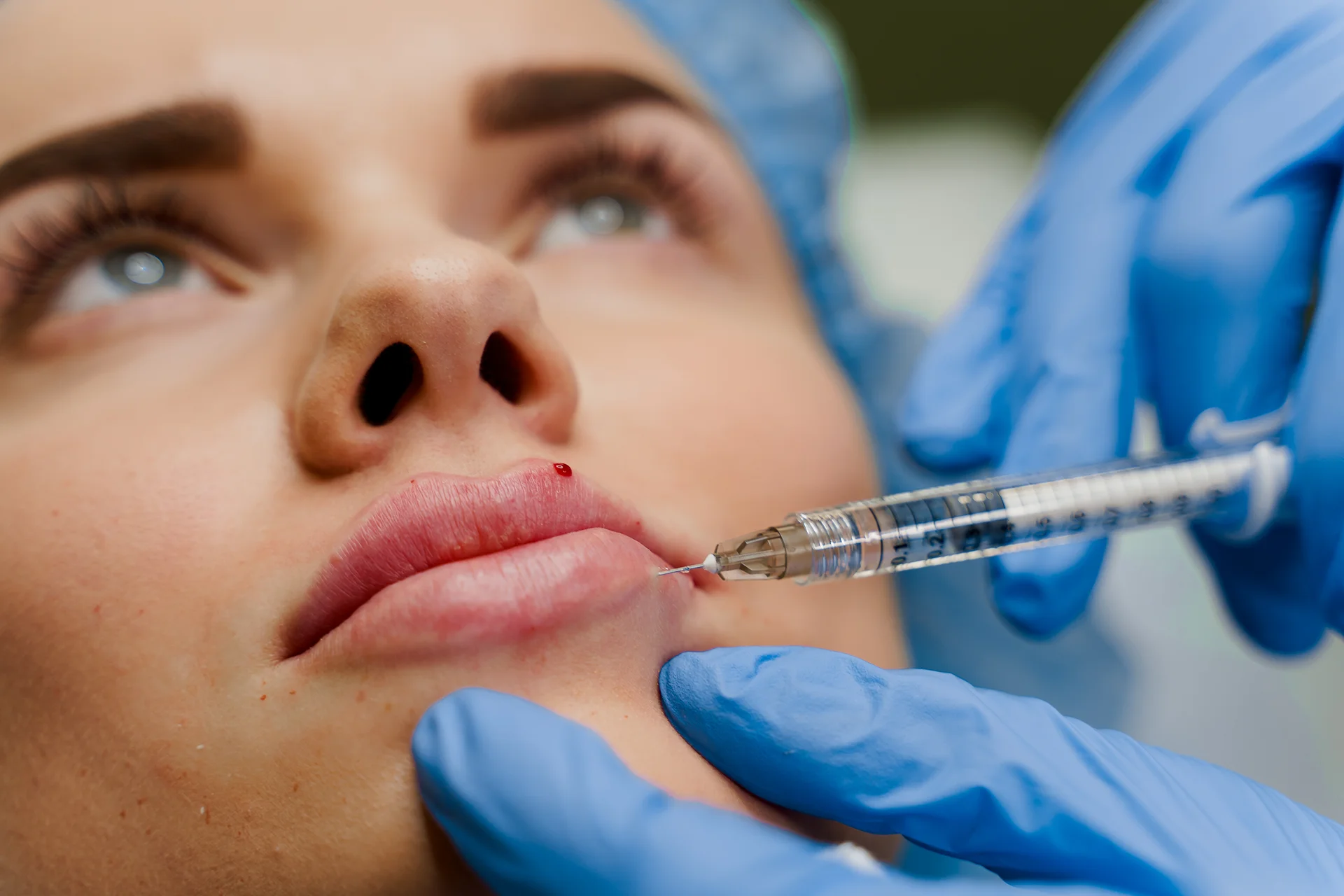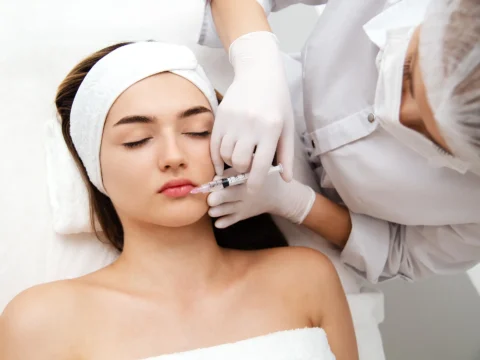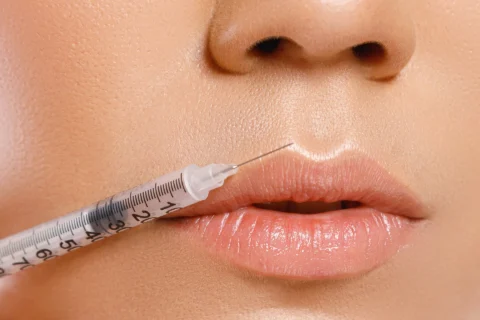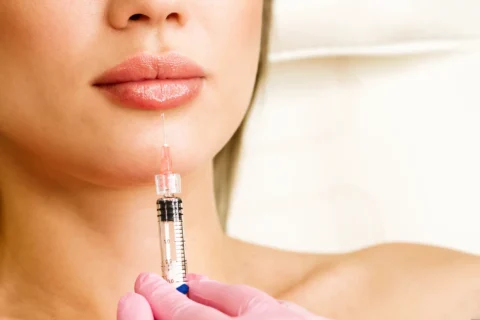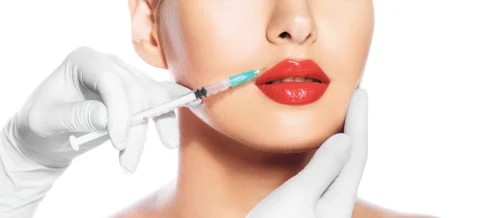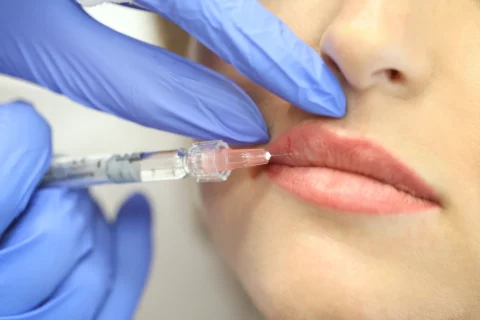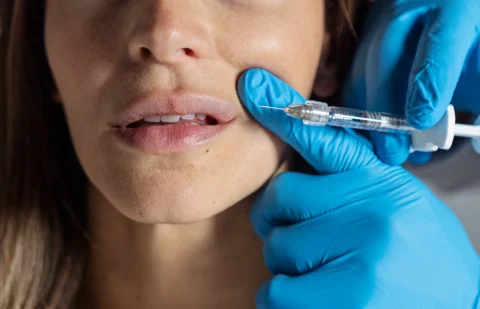What You Need to Know About Lip Necrosis and Fillers
Lip necrosis is a serious, albeit rare, complication that can arise from lip filler injections. It results from disrupted blood supply to the lip tissue, often due to improper injection techniques. Early detection and understanding of this condition are vital for those considering lip enhancements.
This guide offers essential information on the causes, symptoms, and effective management of lip necrosis, highlighting the importance of skilled practitioners and post-treatment vigilance.
What Are Dermal Fillers?
Dermal fillers are injectable products used to add volume under the skin. They contain hyaluronic acid, a molecule that binds to water and expands. When skillfully injected into the lips, fillers can create a plumper, smoother appearance.
Why Are They Used for Lip Enhancement?
Dr. Soni states that when done by a skilled professional, lip fillers provide a fast and low-risk method to achieve improved lip shape and size, making them an attractive choice for cosmetic enhancements.
What is Lip Necrosis?
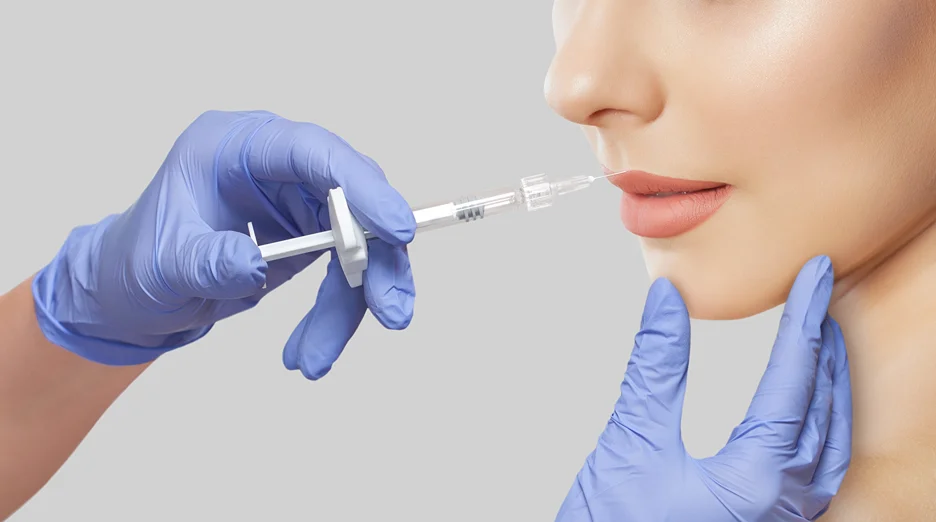
Lip necrosis refers to the death of skin and underlying soft tissue in the lips. It is an uncommon but serious risk associated specifically with dermal filler injections in the lip area.
How Does It Relate to Lip Fillers?
According to Dr. Soni, necrosis can occur when lip fillers are inadvertently injected into a blood vessel, obstructing the blood supply to the surrounding tissue.
Deprivation of oxygen and nutrients causes the tissue to die off. Forceful injection pressure or excessive volumes can heighten this risk. The lips’ intricate vascular anatomy demands great caution during injections.
What Are the Symptoms of Lip Necrosis After Fillers?
Recognizing the early signs of lip necrosis following filler injections is crucial for preventing severe complications. Here’s a closer look at the symptoms to be aware of:
Identifying Early Signs
- Discoloration and Blanching: Initially, you might notice unusual paleness or discoloration in certain areas of the lips. Dr. Soni points out that this is often one of the first indicators of compromised blood flow to the tissue.
- Formation of Nodules or Bumps: Small, hard lumps or nodules may develop, which can be a sign of an adverse reaction to the filler or an early symptom of tissue distress.
Symptom Progression
- Increased Pain and Swelling: As the condition progresses, the affected areas of the lips can become increasingly painful and swollen. This swelling is not just the typical mild swelling seen post-injection but is more pronounced and persistent.
- Development of Ulcers: Within a few days, if the issue is not addressed, ulcers may form. These are painful sores or breaks in the skin, indicating severe tissue damage.
- Skin Breakdown and Necrosis: The most alarming stage is when the skin begins to break down, leading to necrosis – the death of tissue. This can manifest as darkened patches on the lips where the cells have died.
- Risk of Scarring and Deformation: If left untreated, lip necrosis can lead to significant scarring and deformation of the lips, which might require complex reconstructive procedures to correct.
Dr. Soni strongly advises maintaining a high level of vigilance following lip filler procedures. He highlights the importance of closely monitoring for any subtle changes and stresses the need for immediate medical attention if anything appears unusual.
According to Dr. Soni, it’s essential not to overlook minor variations as normal post-procedure swelling or bruising. He underscores that early detection and prompt treatment are crucial in preventing long-term damage.
Who is at Risk of Lip Necrosis After Lip Fillers?
While lip necrosis can potentially occur in anyone receiving lip fillers, certain factors can elevate the risk:
- Incorrect Injection Technique: If the filler is injected improperly and enters the blood vessels supplying the lips, it can block these vessels, cutting off blood flow and leading to tissue death.
- Excessive Filler in One Area: Using too much filler in a single area can compress surrounding blood vessels, disrupting normal blood flow.
- Pre-existing Vascular or Healing Disorders: Individuals with a history of vascular disorders or conditions like diabetes, which impair wound healing, are at increased risk. Poor circulation in such cases makes necrosis more likely.
- Recent Lip Trauma or Injury: Injecting filler into areas of the lips that have recently experienced trauma or injury is risky. These tissues already have reduced blood flow and are more susceptible to complications.
- Lack of Practitioner Expertise: The experience and training of the practitioner are crucial. Inexperienced injectors may inadvertently affect sensitive structures in and around the lips.
How Can Lip Necrosis Be Prevented?
Prevention is key when it comes to reducing the risk of lip necrosis following filler injections.
- Selecting the Right Practitioner: The importance of choosing an experienced and qualified injector cannot be overstated. Dr. Soni emphasizes that necrosis is largely avoidable with proper technique and precise placement of the filler.
- Pre-Procedure Care: He suggests that patients should consider stopping smoking at least two weeks before and after the procedure. This helps improve blood flow and overall healing.
- Informed Consultation: A thorough consultation before the procedure can help identify any potential risk factors specific to the individual. This includes discussing medical history, current medications, and lifestyle habits.
- Aftercare and Monitoring: Following the procedure, patients should be provided with clear aftercare instructions and what signs to look out for. Prompt attention to any unusual symptoms can lead to quicker intervention and better outcomes.
If Lip Necrosis is Suspected: Diagnostic and Immediate Response
Recognizing and addressing lip necrosis promptly is crucial in minimizing its impact. Here’s an overview of how it’s typically assessed and the immediate actions that should follow:
Diagnostic Approaches
- Physical Examination: Initially, the injector or medical professional will conduct a thorough examination of the lips. This includes palpating (feeling) the area to check for signs of blocked blood flow or tissue damage. Dr. Soni notes that this step is critical in assessing the extent of the issue.
- Use of Imaging Tests: In some cases, additional diagnostic tools like ultrasound imaging might be employed. These tests can help in visualizing blood flow and assessing the filler’s placement and its effects on surrounding tissues.
What Immediate Actions Should Be Taken?
- Intervention with Hyaluronidase: At Ethos Aesthetics + Wellness, Dr. Soni explains that if vascular compromise is suspected or confirmed, hyaluronidase is promptly injected. This enzyme works to dissolve the filler that may be causing the obstruction, thereby alleviating the issue.
- Close Monitoring: Following the intervention, it’s crucial to monitor the patient closely for any signs of improvement or further complications. This monitoring typically continues over the next 24 hours to ensure that the situation is under control.
- Emergency Evaluation: Seeking an emergency medical evaluation is vital. If you’re experiencing symptoms of lip necrosis, it’s important not to delay in seeking help. The sooner the treatment begins, the better the chances are of reducing permanent damage.
What Are the Treatment Options for Lip Necrosis?
Dr. Soni states that once diagnosed, there are several therapies that may be used to try to restore blood supply and salvage the damaged tissue. These include:
- Hyaluronidase Injections: This enzyme is crucial for breaking down hyaluronic acid fillers, helping to alleviate blockages in blood vessels and restore normal blood flow.
- Medications to Improve Circulation: These can include agents like aspirin or other blood thinners to reduce clot formation and enhance blood flow to the affected area.
- Hyperbaric Oxygen Therapy (HBOT): HBOT involves breathing pure oxygen in a controlled environment, which can significantly increase oxygen supply to the damaged tissues, aiding in their recovery.
- Surgical Debridement: In cases where tissue death is extensive, surgical removal of necrotic tissue may be necessary to prevent the spread of damage and promote healing.
An experienced injector can quickly initiate proper protocols. However, managing necrosis requires close coordination between the aesthetic provider, the patient, and sometimes other specialists.
What Does Recovery Look Like and What Are the Long-Term Effects?
The recovery trajectory depends on how rapidly necrosis is identified and treated. Here’s what to expect:
- Healing Journey: Dr. Soni explains that with early intervention, symptoms like swelling and discoloration start to improve as new blood vessels form and pain and numbness decrease. The healing duration depends on the severity of the necrosis, ranging from weeks to months for full recovery and proper wound care.
- Long-Term Outlook: If significant portions of the lips underwent necrosis, some scarring and asymmetry may remain. In the worst cases, patients may need reconstructive surgery for large divots or deformities.
Thankfully, complete lip loss is extremely rare when complications are appropriately managed. Still, necrosis can impact the lips’ long-term aesthetics to varying degrees.
FAQs on Lip Necrosis and Fillers
Is Lip Necrosis Avoidable?
Yes, to a large extent. Choosing an expert provider with proper injection techniques significantly reduces the risk. However, there’s always a potential risk of complications like necrosis with cosmetic fillers.
How Soon Can Necrosis Occur Post-Injection?
Early signs of necrosis usually appear soon after the filler injection, either immediately or hours after the procedure.
Many cases of necrosis occur after injection, but there are also papers describing delayed necrosis. It is believed that delayed necrosis is caused by vessel compression following hyaluronic acid injection.
Should Smokers Avoid Lip Fillers?
Smoking heightens the risk of infection and slows healing after lip fillers. It’s recommended to avoid smoking for at least 2 weeks before and after the procedure, especially for heavy smokers, to reduce complications.
Can Lip Massages Prevent Necrosis?
Lip massages might help distribute the filler more evenly, but they are not a guaranteed method to prevent vascular occlusion, which can lead to necrosis.
Are Certain Fillers More Likely to Cause Necrosis?
The risk of necrosis is more about the technique and placement of the filler rather than the type of filler used. Hyaluronic acid fillers are generally considered safer. Lip necrosis is more common when using denser or more permanent fillers.
Is Necrosis Risk Higher with Lip Fillers Compared to Other Areas?
Yes, the risk is higher with lip fillers due to the intricate anatomy and dense vascular network of the lips, requiring exceptional precision during the procedure.
Conclusion: Why is Awareness Crucial in Cosmetic Procedures?
While dermal fillers provide an accessible means of achieving plumper lips, rare but serious risks like necrosis do exist. Being informed on the signs, prevention strategies, and treatment empowers patients to make smart choices.
As Dr. Soni of Ethos Aesthetics + Wellness stresses, selecting an experienced and reputable injector is key to minimizing these risks. Do your homework to find someone qualified – then you can relax and enjoy your enhanced lips.
Stay vigilant afterwards and speak up at the first hint of anything amiss. Your provider’s expertise combined with your awareness is the ultimate formula for safety in any cosmetic treatment.
Trust Your Lips to Dr. Hardik Soni at Ethos Aesthetics + Wellness

When it comes to lip fillers, safety is as important as beauty. Dr. Hardik Soni at Ethos Aesthetics + Wellness combines both.
Dr. Soni’s expertise minimizes the risk of complications like lip necrosis, ensuring your treatment is not just effective, but also safe.
Book online now for your first consultation and step towards beautiful, worry-free results. Trust your lips to the best – you’re in expert hands with us.

